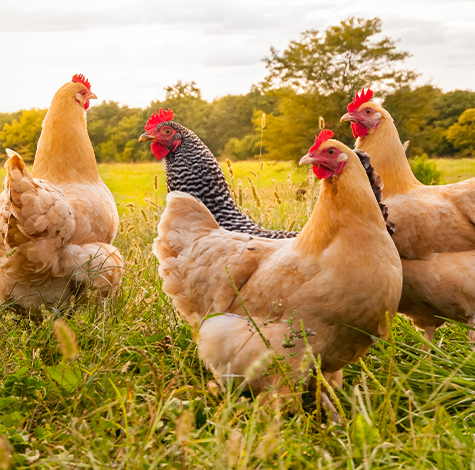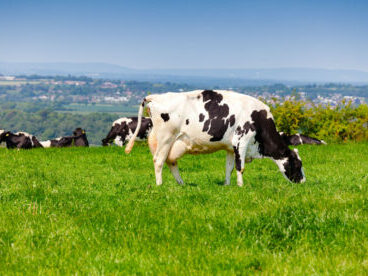Find out how different fat supplements affect dairy cows and the primary differences between rumen-inert, rumen-active and rumen-protected fats.
What is the ideal fat supplement for your dairy cow?
Why do we feed fats to dairy cows? The key reason has to do with the increased energy density of fats to carbohydrates, as fats typically contain at least two and a half times the energy available from carbohydrates. In other words, less food for more energy. However, research has demonstrated that fatty acids also influence different physiological processes, including the immune system and reproductive processes, in ways that are not energy-related. Not all fats are the same, and different fat supplements vary in their fatty acid composition and effect on animal metabolism. Similarly, fats and oils can affect rumen function and, in some cases, may adversely affect the rumen microflora. This could lead to reduced fibre digestion and milk fat depression.
The Main Fat Sources for Dairy Cows
There are three main types of fat supplements currently marketed in the UK; these are each classified for dairy rations based on their rumen responses. Most groupings look at the impact a fat source has on the digestibility of the basic feed ingredients and in specific forages. How much the supplement resists rumen biohydrogenation (the process where unsaturated fatty acids are converted to saturated fatty acids by the rumen microbes) is equally important because some of the resulting products from the process can cause milk fat depression. On this basis, fat supplements can be categorised either as rumen-active, rumen-inert or rumen-protected.
What’s the difference between rumen-active, rumen-inert, and rumen-protected fats?
Rumen-active fats
Vegetable and marine oils fed straight are categorised as rumen-active fats. In particular, unsaturated long-chain fatty acids resulting from the hydrolysis of lipids in the rumen can cause rumen unsaturated fatty acid load (RUFAL), which interferes with rumen fermentation. This leads to reduced fibre digestion and ultimately results in reduced feed intake and lowered animal performance.
Rumen-inert fats
Rumen-inert fats are specially designed to have minimal effect on rumen function, feed digestibility and dry matter intake when fed to dairy cattle. They have the advantage of being dry fats that are easy to handle and can be mixed into the ration without the need for specialised dosing equipment. This group of fat supplements includes those that are protected within a carrier matrix of vegetable fibre and or clay minerals. The process is natural and does not affect the physical or chemical nature of the fatty acids. What’s the benefit of rumen-inert fats? This blend of the component oils and fats can be manipulated at various stages of lactation to meet the exact needs of the dairy cow.
Environmental concerns and health awareness of consumers have increased public demand for sustainable feeding stuffs and healthy livestock products. Corporations and supermarkets have had to adopt resilient and sustainable supply chain strategies, be they lowering carbon emissions from shipping foods across the world, or issues such as deforestation and land degradation associated with food production. Customers are opting to purchase foods with higher contents of bioactive compounds, such as omega-3 fatty acids. How does this all relate to fat supplementation? The composition of milk fat and other livestock products can be regulated by supplementing animals with different fat sources, such as vegetable and marine oils, to meet consumer preferences of healthiness and environmental protection.
Feeding dairy cows fat supplements rich in unsaturated fat, like a rumen-inert fat supplement, also offers dairy farmers the opportunity to improve their environmental credentials by reducing methane emissions and increasing feed efficiency. Methane production accounts for between 2 and 12% of energy loss from the diet of the dairy cow–energy which could otherwise be used for milk production. Unsaturated fatty acids mitigate methane production through their inhibitory effect on methane-producing microbes in the rumen.
Rumen-protected fats
Rumen-protected fat is a term mostly applied to fat sources designed to resist alterations by rumen microbes and become available for digestion in the lower gut. Calcium salts of palm fatty acids are the most common products in this range. It is worth noting these supplements are fixed in their composition and cannot be altered in order to meet the needs of the dairy cow at different stages in the lactation cycle. They are known to reduce dry matter intake and diminish the overall energy supply from the ration. These supplements lack in the omega-3 fatty acids that are essential to animal nutrition and consumer wellbeing. As they are often sourced from palm oil, their impact on the environment is also under frequent scrutiny.
Calcium soaps are so-called due to the chemical reaction involving palm fatty acid distillate and calcium hydroxide to form calcium salts of fatty acids. The rumen protection is highly dependent on rumen pH which should be maintained above 6.0 in order to minimise breakdown in the rumen in a significant way. However, this is not always practical as we know energy-dense dairy rations with high content of readily fermentable carbohydrates can cause acidic conditions in the rumen. This could result in the dissociation of the products and potentially harm rumen function.
What fat supplement should I feed my cows?
When deciding on a fat supplement, the key deciding factors to consider are the fatty acid composition, the optimisation of rumen function and fat digestibility. These factors influence the nutrient and energy supply from the total diet and dairy cow productivity.
Because of their low density, calcium soaps tend to be trapped in the rumen fibre mat, increasing their resident time in the rumen and the risk of dissociation. On the other hand, rumen-inert fats like the kinds encapsulated in the fibre matrix are denser, mix well with rumen fluid and readily exit to the lower gut for digestion and absorption. In short, these supplements are less disruptive to rumen function.
To mitigate the potential adverse effect of fatty acids on rumen function, it is also possible to incorporate in rumen-inert fats a rumen buffer to help maintain optimal conditions for rumen fermentation. We have recently demonstrated through independent scientific research that it is possible to feed dairy cows fats high in unsaturated fatty acids and still maintain high yields of milk and milk constituents–a clear indication that the rumen is functioning optimally.
In the study, our rumen-inert fat supplement replaced calcium soap weight for weight and increased milk yield by 0.6kg/cow/day. Similarly, milk fat and protein levels improved by 0.16% and 0.03%, respectively. Butterfat and protein contents of milk provide value to processors. Most buyers design their buying contracts to incentivise farmers to deliver more of the milk solids they need to generate value in their markets. According to AHDB, milk delivered below buyer specifications for fat and protein costs UK dairy farmers in the region of £55 million annually.
The myth that high levels of unsaturated fats cannot be fed to dairy cows without affecting fibre digestion and milk fat levels is just that, a myth.
Similar to the evolution from protein to amino acid formulation in dairy nutrition, ongoing research shows that not all fatty acids are of equal nutritional value. Some are more essential than others at various stages of lactation. Known effects include the synthesis of prostaglandins from linoleic acid, which is vital during calving. The omega 3 fatty acids consisting mainly of linolenic acid, EPA and DHA are involved in the production of progesterone responsible for the maintenance of pregnancy, i.e., improved health of ovarian follicles and embryo quality and reduced embryo loss. The precise formulation of fatty acids into dairy cow rations is currently only practical with rumen-inert fats.
The benefits of using rumen-inert fats
Rumen-inert fat supplements offer the farmer the choice of products which supply the essential fatty acids to the dairy cow with beneficial effects on dry matter intake, rumen metabolism, digestibility, energy partitioning, milk components synthesis, body condition, immune system and reproductive performance. Together, these make it possible for nutritionists to design fatty acid feeding strategies to support tangible animal performance and positive consumer perception of dairy products.


 Back to News
Back to News 



